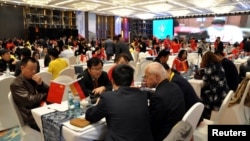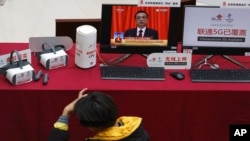While there is still no timetable for issuing a long-expected executive order restricting U.S. outbound investments in sensitive sectors to China, a senior Treasury official said the administration is focused on a "narrow and tailored" approach in establishing such a screening mechanism.
Speaking before a Senate Banking Committee hearing on Wednesday, Paul Rosen, who oversees investment security at the Treasury Department, said officials are working on screening investment from the United States that "comes with know-how and expertise to certain specific sectors and subsectors, such as advanced semiconductors, artificial intelligence and quantum computing."
Rosen said the mechanism is designed to stop American investments from being used for technologies that enhance military or intelligence capabilities in "countries of concern," citing China's challenge to U.S. economic and security interests.
When launched, the mechanism could be another tool for the administration to curb Beijing's military advancement following two significant measures enacted in 2022 - namely, new export control rules on the semiconductor industry and the CHIPS Act, which boosts domestic semiconductor research and manufacturing.
The administration is engaging allies in the effort, including during the Group of Seven summit in Hiroshima, Japan, last month, where leaders agreed that outbound investment restrictions could complement existing tools targeting inbound investments and export controls.
How screening would work
The executive order would first establish a pilot program within the Treasury Department to gather data on outbound capital flows, said Emily Benson, director of the Center for Strategic and International Studies' Project on Trade and Technology.
"Where they're going, who is funding the capital flows, which sectors they are pouring into, so that we can have a better idea of what to restrict, if anything, moving forward," she told VOA.
Setting up a regime that is surgical yet extensive enough to be effective is challenging. To begin with, just defining what constitutes an American firm is already "a complex legal exercise," considering that investment often flows through multiple countries and different funds, said Martin Chorzempa, senior fellow at the Peterson Institute for International Economics.
There are also concerns the restrictions will increase burdens on U.S. high-tech sector investors and scare off foreign companies from doing business.
"If they feel they're going to have to choose between investing in the United States and investing in China, some might decide that it makes more sense for them to invest in China," Chorzempa told VOA.
One way to ease concerns would be to avoid a blanket ban, said Dennis Wilder, former National Security Council director for China who is now a senior fellow for the Initiative for U.S.-China Dialogue on Global Issues at Georgetown University.
Asking companies to report their investments in certain areas but not require them to get prior approval from the U.S. government would be "less intrusive on business," Wilder told VOA.
The administration has been working on the executive order at least since August 2022, after provisions of the 2021 National Critical Capabilities Defense Act did not make it into the final version of the CHIPS Act.
Last October, the White House stated it was moving ahead with the program, mentioning "screening of outbound investment" as an approach to address national security threats under its National Security Strategy.
In May, Senate Democrats proposed new legislation that would limit American technology and capital from going to Chinese companies. Should the bill pass, it could complement any executive action the administration might enact.
Beijing has said the plan is "harmful and serves no one's interests."
"China is firmly opposed to the U.S. politicizing and weaponizing trade and sci-tech issues, creating obstacles for normal technological cooperation and economic and trade exchanges in the industrial community and private sectors, and disrupting the global industrial and supply chains," Chinese Foreign Ministry spokesperson Mao Ning said during her Thursday press briefing.
Tariffs on Chinese products
Meanwhile, President Joe Biden is still reviewing whether he wants to maintain tariffs on billions of dollars' worth of Chinese imports that date from the Trump administration.
Last year, his administration initiated a review of the tariffs, asking industries to weigh in on their efficacy and potential continuation. It is unclear when the review will be completed.
As the administration struggled to contain high inflation last year, there were suggestions in favor of lifting some "non-strategic" tariffs, including from U.S. Treasury Secretary Janet Yellen. However, observers say that heading into the U.S. presidential election in 2024, any argument to lift tariffs would not be popular politically.
In a Saturday interview with Reuters, Deputy U.S. Trade Representative Sarah Bianchi said the administration is taking an analytical approach to its review.
The administration has been working to lower tensions with China that spiked after a U.S. fighter jet shot down a suspected Chinese espionage balloon over American territory in February. There have been signs of warming ties, including the resumption of meetings in May between top Chinese commerce official Wang Wentao and U.S. Commerce Secretary Gina Raimondo and U.S. Trade Representative Katherine Tai.
The executive order's release has been anticipated for months, with no formal release date. It is unclear whether the delay is linked to the bigger strategic goal of rapprochement with Beijing or the complexity of setting up the regime and giving more time for allies to be on board.
"You can't really do this whole new expansive tool and then go to Beijing. And conversely, you can't go to Beijing and then come back and announce this big tool," Benson said. "And so, there has to be a very carefully managed process of the release. And it is a huge gamble."
Both Washington and Beijing appear keen for ties to improve ahead of the Asia Pacific Economic Forum that Biden is set to host in San Francisco in November. Chinese President Xi Jinping reportedly wants to attend.
Paris Huang contributed to this report.











